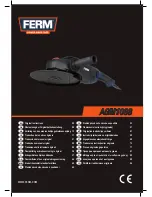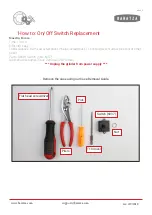
6
Entanglement hazards
Hazard related to entanglement may cause choking, scalping and/or
cutting wounds when loose clothes, jewellery, hair or gloves are not
kept at a safe distance from the tool or accessories.
Work related hazards
Tool operation may be hazardous to operator's hands, e.g. by
pinching, hitting, cutting, abrasion or burns. Wear appropriate gloves
for hand protection. Operator and maintenance personnel must be
physically fit to handle the weight and power of the tool. Hold the tool
correctly. Be prepared to counter-act against normal or unexpected
movements and always have both hands ready. Maintain balance
and keep safe position of your feet. Release the pressure on
start/stop element in case of power outage. Use only lubricating
media recommended by the manufacturer. Use protective glasses,
it is also recommended to wear well fitted gloves and protective
clothes. Make sure the accessories do not work at speeds that
exceed their rated speed. Wear helmet when working above your
head. Be careful and watch out for rotating parts even after releasing
the start and stop trigger. Make sure the material processing does
not cause fire.
Hazards related to repetitive movements
When using a pneumatic tool for operation that involves repetitive
moves, the operator is exposed to discomfort of hands, arms,
shoulders, neck and other body parts. When using a pneumatic tool,
keep comfortable body posture that ensures the right feet position
and avoid uneasy or unbalanced body postures. Change your body
posture when working for a long time, it helps to avoid discomfort
and fatigue. When experiencing constant or recurring discomfort,
pain, pulsating pain, tingling, numbness, burning sensation or
stiffness, do not ignore the symptoms, inform your employer and
consult a doctor.
Hazards related to accessories
Disconnect the tool from power supply before changing the working
tool or an accessory. Avoid direct contact with the working tool just
after operation, it may be sharp or hot. Use accessories and
consumables only in sizes and types recommended by the
manufacturer. Do not use accessories of other types or other sizes.
Make sure the maximum operating speed of the working tool is
higher than the rated speed of the device. Never install grinding
wheels, grinding discs or mills on the grinder. Grinding disc cracking
may cause serious body injuries or even death. Never use wheels
with dents, damages or when dropped. Make sure to use tools with
correct mounting diameter. Notice that speed allowed at installation
point is lower due to increased shaft length between collet end and
the installation point. Make sure that minimum installation length is
10 mm. Bear in mind the risks when the working tool diameter does
not match the collet diameter.
Workplace related hazards
Slipping, tripping and falling are the main reasons of injuries. Avoid
slippery surfaces when using the tool and tripping hazards caused
by compressed air system. Be careful in unknown environment.
There may be hidden dangers, such as electricity or other utility
systems. The pneumatic tool is not designed for use in explosion
hazardous areas and has no electric insulation. Make sure there are
no electric wires, gas pipes etc. that may be dangerous when
damaged with the tool.
Dusts and fumes related hazards
Dusts and fumes produced with the pneumatic tool may cause bad
health condition (e.g. cancer, congenital defects, asthma and/or
dermatitis), so the risk assessment is necessary, and
implementation of appropriate control measures for the hazards.
The risk assessment should include impact of dust produced with
the tool and possibility to stir up and lift existing dust. Operate and
maintain the pneumatic tool in accordance with the instruction
manual, which allows to minimise unnecessary emission of vapours
and dusts. Air outlet should be directed in a way to minimise stirring
up dust in dusty environment. Wherever dust and fumes are
produced, it is a priority to control the emission at the source. All
integrated functions and equipment used for collection, extraction
and reduction of dust or smoke should be used appropriately and
maintained in accordance with the manufacturer's guidelines.
Select, maintain and replace working tools in accordance with the
guidelines in the manual to prevent increased vapours and dusts
production. Use respiratory tract protection in accordance with the
employer instructions, as well as occupational health and safety
rules. Processing certain materials produces dusts and fumes,
which can form potentially explosive environment.
Noise hazards
Exposure to high noise without any protection may cause permanent
and irreversible hearing loss and other problems, such as tinnitus
(sensation of ringing, buzzing, whistling or humming in ears). Risk
assessment is necessary, and implementation of appropriate control
measures related to the hazards. Appropriate control aiming to
reduce risks can include measures such as silencing materials to
prevent “ringing” of processed piece. Use hearing protection in
accordance with the employer instructions, as well as occupational
health and safety rules. Operate and maintain the pneumatic tool in
accordance with the instruction manual, which allows to prevent
unnecessary increase of noise. Select, maintain and replace worn
out working tools in accordance with the instruction manual. It will
prevent unnecessary increase of noise. When the pneumatic tool is
equipped with a muffler, always make sure it is installed properly
when operating the tool.
Vibration hazards
Exposition to vibrations may cause permanent injuries of nervous
and vascular systems in hands and arms. Wear warm clothes when
working in low temperatures and keep your hands warm and dry. In
case of numbness, tingling, pain or whiteness of skin on fingers or
hands, stop using the pneumatic tool, inform your employer and
consult a doctor. Operation and maintenance of the pneumatic tool
in accordance with instruction manual allows to avoid unnecessary
increase of vibrations. Select, maintain and replace consumables
and working tools in accordance with the guidelines in the manual
to prevent hazardous increase of vibrations. Support the tool weight
with a stand, tensioner or with a balancer. Vibration hazards are
usually higher with stronger hand grip, therefore hold the tool with
light but firm grip, while considering reaction forces that may appear.
Incorrect installation of cutting tool may cause increase of vibration
level.
Additional safety instructions regarding pneumatic tools
Pressurised air may cause serious injuries:
•
always cut off air supply, release air pressure from the hose and
disconnect the tool from air supply at all times, when the tool is
not in use, before changing accessories or before repairs;
•
never direct air stream at yourself or another person.
Hitting with a hose may cause serious injuries. Always inspect the
equipment for damaged or loose hose and connectors. Make sure
to direct cold air away from hands. Each time when universal rotation
joints are used (claw couplings), use securing pins and securing
fasteners that protect from damages between hoses and between a
hose and the tool. Do not exceed maximum air pressure specified
for the tool. Never carry the tool when holding by its hose.
EXPLANATION OF USED SYMBOLS
1. Read instruction manual, observe warnings and safety conditions
therein!
2. Use personal protection equipment (protective goggles, earmuff
protectors).
3. Use protective gloves.
4. Protect the tool from water.
5. Keep the tools away from children.
6. Recycling
INSTALLATION DIAGRAM
1. Pneumatic tool
2. Quick coupler
Summary of Contents for 14-508
Page 2: ...2...
Page 8: ...8 14 508 ISO 11148 10...





































